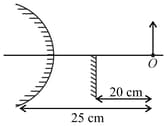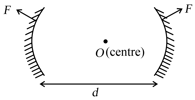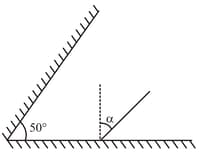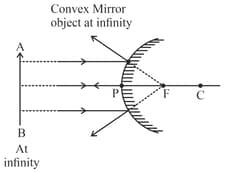Reflection at Plane and Spherical Surfaces
Reflection at Plane and Spherical Surfaces: Overview
This topic covers concepts, such as Reflection of Light, Incident Ray, Laws of Reflection of Light, First Law of Reflection, Second Law of Reflection, Reflection from a Plane Mirror, Sign Convention in Mirrors, Co-ordinate Convention, etc.
Important Questions on Reflection at Plane and Spherical Surfaces
A luminous point object is placed at , whose images is formed at as shown in the figure. is the optical axis. Which of the following statements are correct?

An object is placed in front of a convex mirror at a distance of 50 cm. A plane mirror is introduced covering the lower half of the convex mirror. If the distance between the object and the plane mirror is 30 cm, it is found that there is no gap between the images formed by the two mirrors. The radius of the convex mirror is:
In the figure shown, the image of a real object is formed at point I. AB is the principal axis of the mirror. The mirror must be:

The reflection surface of a plane mirror is vertical. A particle is projected in a vertical plane which is also perpendicular to the mirror. The initial velocity of the particle is 10 m/s and the angle of projection is 60o. The point of projection is at a distance 5 m from the mirror. The particle moves towards the mirror. Just before the particle touches the mirror the velocity of approach of the particle and its image is:
A large temple has a depression in one wall. On the floor plan, it appears as an indentation having a spherical shape of radius . A worshipper stands on the centreline of the depression, out from its deepest point, and whispers a prayer. Where is the sound concentrated after reflection from the black wall of the depression?
Incident parallel rays make an angle of with the axis of a concave mirror of focal length at pole of the mirror. The perpendicular distance of image from the axis is nearly.
A car of length inch moves at a constant velocity . A man wants to take a photo of side view of the car. The size of the image of the car is long. The time of exposure needed for the car to get a clear picture, if the image should not move more than , is
A plane mirror is placed along X-axis facing toward Y-axis. The one end of the mirror is at its origin. The equation of the image of an object is
In the figure, an object is placed at distance from the surface of a convex mirror, and a plane mirror is set so that the image formed by the two mirrors lie adjacent to each other in the same plane. The plane mirror is placed at from the object. What is the radius of curvature of the convex mirror?

If image of '' is formed at '' itself find values of ''.

The figure shows two plane mirrors inclined at . A ray is incident on one of the mirrors at an arbitrary angle . It gets reflected from this mirror and then from the other mirror.

The angle between the incident ray and the emergent ray is
An object is placed at from the concave mirror of focal length the nature of the image and magnification will be
Linear magnification in terms of distance is given as:
Magnification equation is given as :
Where the origin is taken, while solving problem regarding the spherical mirror
In the following, ray diagram of convex mirror,when object is placed at infinity then the nature of the image is _____________.

In a convex mirror, magnification is
In a concave mirror for real images magnification is taken in respect of heights.
When object is placed to the left side of a mirror,the object distance is always__________.
Centre of curvature of a concave mirror lies___________.
